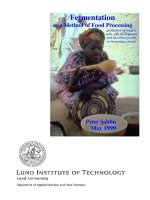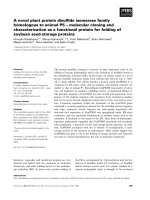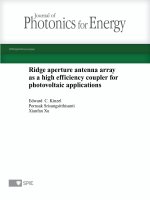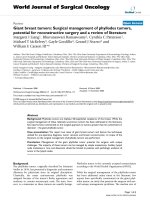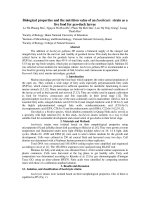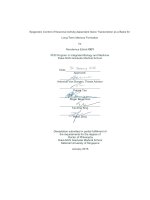Potential for ginkgo biloba as a functional food
Bạn đang xem bản rút gọn của tài liệu. Xem và tải ngay bản đầy đủ của tài liệu tại đây (2.28 MB, 226 trang )
POTENTIAL FOR GINKGO BILOBA
AS A FUNCTIONAL FOOD
LENA MEI LING GOH
(B.SC. (HONS.), LEEDS, UK)
A THESIS SUBMITTED
FOR THE DEGREE OF DOCTOR OF PHILOSOPHY
FOOD SCIENCE AND TECHNOLOGY PROGRAMME
C/O DEPARTMENT OF CHEMISTRY
NATIONAL UNIVERSITY OF SINGAPORE
2004
Page 2of 201
ACKNOWLEDGEMENTS
This study was carried out at the National University of Singapore, Department
of Chemistry. This academic dissertation was produced under the Food Science and
Technology Programme of the Chemistry Graduate School of Science.
I wish to express my deepest gratitude to my supervisor, Dr Philip J. Barlow, for
his encouragement to start this work and for the opportunity to be a member of the
inspiring research group. His endless support and constructive criticism has been
precious during these years. I thank him also for his inventive comments and
suggestions, especially during the writing phase. His never failing support and patience
during these years were vital to the success of the study. The knowledge you shared with
me and your scientific criticism are gratefully acknowledged.
I owe my thanks to Professor Hian Kee Lee, Head of the Department of
Chemistry, for providing the facilities for my work in his department and for his support.
I wish to thank him also, for his support and advice during my first steps as a Ph.D.
student. I would also like to thank Dr. Leong Lai Peng, A/P Weibiao Zhou and A/P
Perera Conrad O., from the Food Science and Technology Programme for providing
various research equipment for my investigations in their laboratories. Their valuable
advice and knowledge have sparked off many research ideas for my work.
I am grateful to Mdm. Lee Chooi Lan, Ms Lew Huey Lee, Mrs Lim Guek Choo,
Frances, Mdm Toh Soh Lian and Ms Tang Chui Ngoh for their excellent technical
assistance. My colleagues and friends in the Food Science and Technology Programme
deserve warm thanks, for making my work easier during these years, for giving a hand in
solving problems, and for providing a pleasant working atmosphere. My special thanks
go to Anne Bruneau, M.Sc., and Chuan Hong Tu, Ph.D. for pleasant and inspiring
working atmosphere in the lab. It was indeed a pleasure to work with people that have
Page 3 of 201
such a good sense of humour! My warm thanks go to my colleagues Sok Li Tay, M.Sc.,
Yean Yean Soong, M.Sc., Cui Min, and Tze Han Lim for inspiring discussions and
sharing good moments when writing this thesis. I am also indeed grateful to have good
friends like David J. Young, Ph.D., Suna Goh, Chia Lee Koh, Jing Xuan Xie, Yi Qin Pan
& Hui Ying Lee for being around me and being ever so patient and understanding for the
times that I am so attached to my work.
Special thanks to Dr. Yong Eu Leong and his students from the Department of
Obstetrics and Gynaecology for the collaborative work in investigation for the
oestrogenic activity in the various Ginkgo biloba plant parts’ extracts. Their efforts and
time put in is greatly appreciated.
Special thanks also go to Martin Fletcher from California Gardens for making the
effort in helping and supplying me with the constant source of Ginkgo leaves for my
experiments.
My warmest thanks belong to my parents, William and Ann Goh and my godma,
Lai Eng Heng for their confidence in me and for being always so supportive and
interested in my work and well being. I would like to thank them, my sister Laura Goh,
and my close friends for providing unfailing support to finish this work. My brother
Lawrence Goh, M.Computing. deserves special thanks for his friendship, advice, prayers
and continuous encouragement during my academic career.
Finally, my dearest thanks are addressed to my fiancée, Meng Yew Leong, M.BA
(Finance) for his love and tireless support.
Page 4 of 201
TABLE OF CONTENTS
ACKNOWLEDGEMENTS 2
LIST OF ABBREVIATIONS 11
SUMMARY 12
1 INTRODUCTION 14
2 LITERATURE REVIEW AND BACKGROUND TO THE STUDY 16
2.1
GINKGO BILOBA 16
2.1.1 Phytobiology 17
2.1.2
Ginkgo biloba
leaves 19
2.1.2.1 Traditional Chinese medicine approach 19
2.1.2.2 Controversies 21
2.1.2.3 Folklore vs. Scientific evidence 22
2.1.3 Ginkgo leaf extract - EGb 761 23
2.1.3.1 Description of each component 24
2.1.3.2 Biological action of Ginkgo biloba leaf constituents 25
2.1.3.3 Polyvalent mechanism of action of EGb 761 32
2.1.3.4 Adverse effects 32
2.1.4
Ginkgo biloba
nuts 34
2.1.4.1 Nutritional composition 35
2.1.4.2 Popularity of consumption 35
2.1.4.3 Health related functions 36
2.1.4.4 Adverse effects 36
2.1.5 Leaf extract
vs.
nuts 38
2.1.5.1 Similarities, differences and future potential 39
2.2
FLAVONOIDS AND PHENOLIC ACIDS 41
2.2.1 Chemistry of flavonoids 42
2.2.2 Flavonoids as antioxidants 51
2.2.2.1 Mechanisms of action of antioxidants 52
2.2.2.2 Determination and measurement of antioxidation activity 56
2.2.3 Structure-Antioxidant activity relationship 66
2.3
TERPENOIDS FRACTION 67
2.3.1 Chemistry of Terpenoids 67
2.3.2 Bioactivity 69
2.4
POTENTIAL TOXIC COMPOUNDS 70
2.4.1 Alkaloids 70
2.4.2 Alkylphenols 72
3 AIMS & OBJECTIVES 79
3.1
MAIN FOCI OF THE RESEARCH 79
3.2
HYPOTHESES PROPOSED 81
4 MATERIALS & EQUIPMENT 84
4.1
MATERIALS 84
4.1.1 Test specimens 84
4.1.2 Other test specimens for comparison studies 85
4.1.3 Solvents 85
4.1.4 Chemicals 85
Page 5 of 201
4.2
EQUIPMENT USED 88
5 PROBLEM BASED APPROACH – ANALYTICAL CHOICES & METHODOLOGIES 90
5.1
PROBLEM BASED APPROACH 91
5.1.1 Problem 1 - Compositional analysis of
Ginkgo biloba
specimens 91
5.1.2 Problem 2 - Vitamin analysis - The natural antioxidant present 91
5.1.3 Problem 3 - Effect of heat over time on AOC of
Ginkgo biloba
Nuts 91
5.1.4 Problem 4 - Effect of preparation procedure on AOC of
Ginkgo biloba
leaf infusions
92
5.1.5 Problem 5 –
In vitro
, Simulated Digestion studies 92
5.1.6 Problem 6 –Toxicity consideration 93
5.1.6.1 Colchicine determination 93
5.1.6.2 GA – An allergen 93
5.1.7 Problem 7 – Hormonal studies on the
Ginkgo biloba
specimens 94
5.2
METHODOLOGIES ADOPTED 95
5.2.1 Sample Treatment & Preparation 95
5.2.2 Proximate analysis 96
5.2.2.1 Lipids determination 96
5.2.2.2 Protein 96
5.2.2.3 Moisture 96
5.2.2.4 Ash 96
5.2.3 Vitamins analysis 97
5.2.3.1 Vitamin C 97
5.2.3.2 Vitamin E 97
5.2.4 Fermentation techniques 98
5.2.5 Sensory evaluation 99
5.2.6 Extraction techniques 100
5.2.6.1 Antioxidants - Flavonoids 100
5.2.6.2 Alkaloids 100
5.2.6.3 Alkylphenols 101
5.2.7 AOC determination 104
5.2.7.1 ORAC – Oxygen radical absorbance capacity 105
5.2.7.2 FRAP – Ferric reducing antioxidant power 106
5.2.7.3 ABTS cation decolorisation assay 107
5.2.8 Statistical analysis 109
5.2.9 Qualification and Quantification techniques 110
5.2.9.1 High Pressure Liquid Chromatography technique 110
5.2.9.2 Capillary Electrophoresis determination 116
5.2.9.3 GCMS 117
5.2.10 Digestive system simulation studies 119
5.2.10.1 Gastric fluids 119
5.2.10.2 Intestinal fluids 119
6 RESULTS AND DISCUSSIONS 121
6.1
COMPOSITIONAL ANALYSIS OF GINKGO BILOBA SPECIMENS 121
6.2
EFFECT OF HEAT APPLICATION ON GINKGO NUTS WITH REGARDS TO AOC 124
6.3
EFFECT OF PREPARATION PROCEDURE ON AOC FOR LEAF INFUSION 131
6.3.1 Comparison of AOC results with ABTS and FRAP 133
6.3.2 Comparison studies among Ginkgo Leaves, Green & Black Tea Leaves. 140
6.3.3 Caffeine determination 141
6.3.4 Sensory Evaluation 142
Page 6 of 201
6.4
IN VITRO, SIMULATED DIGESTION STUDIES 145
6.4.1 HPLC analysis for determination of stability of Glycosides and Aglycones 151
6.4.1.1 Qualification 151
6.4.1.2 Quantification 152
6.5
TOXICOLOGICAL DETERMINATION 157
6.5.1 Colchicine determination 157
6.5.2 Ginkgolic acids – as allergen 158
6.5.2.1 SAMPLE PREPARATION 158
6.5.2.2 HPLC ANALYSIS 161
6.5.2.3 GC-MS ANALYSIS 168
7 CONCLUSIONS 174
7.1
POTENTIAL FOR THIS RESEARCH 179
8 SUGGESTIONS FOR FURTHER STUDIES 180
8.1
GINKGO NUTS 180
8.2
GINKGO LEAF INFUSION 180
8.3
IN VIVO VS IN-VITRO ANTIOXIDANT DETERMINATION ASSAY 180
8.4
SIMULATED DIGESTION PROCESS 180
8.5
HORMONAL STUDIES 180
REFERENCES 181
APPENDICES 197
Page 7 of 201
LIST OF FIGURES
Fig 1. The extraction procedure for EGb761 from Ginkgo biloba leaves. 23
Fig 2. Flavonol aglycons that may be present in trace amounts (<0.1%) in EGb761 24
Fig 3. Chemical structures of terpene constituents of EGb 761 – Ginkgolide 24
Fig 4. Chemical structures of terpene constituents of EGb 761 - Terpenoid 25
Fig 5. Shikimic acid pathway 43
Fig 6. Phenylpropanoid metabolism leading to flavonoids, stilbenes, styrylpyrones and coumarins as well
as the precursors for lignin and lignan synthesis 44
Fig 7. Biosynthesis pathways of flavonoids. 45
Fig 8. Interconnections of flavonoids subgroups 66
Fig 9. Chemical Structure and proposed fragmentation pattern of Colchicine 71
Fig 10. Structures of alkylphenols isolated from G. biloba leaves 72
Fig 11. Synthesis of GAs via the polyacetate pathway 73
Fig 12. Generic schematic of the fluorescence system 104
Fig 13. Trolox concentration effect on FL fluorescence decay curve. 106
Fig 14. Calculation of ORAC values 106
Fig 15. Typical UV spectrum of Ginkgolic acids 113
Fig 16. Structure of external standard (syn. 6-heptadecenylsalicylic acid). 113
Fig 17. Major TMS derivatives of GAs, bilobols and cardanols 117
Fig 18. Nuts and Leachate extract and summation of the both to express the total AOC in mg AEAC per
100 g homogenate vs cooking time 125
Fig 19. Composition of heat stable and heat labile antioxidant in Ginkgo dessert during heating 126
Fig 20. AOC contribution by vitamin C in the nuts and in the leachate 127
Fig 21. Absorbance drop vs ferrous sulphate standard concentration 133
Fig 22. Absorbance drop vs ascorbic acid standard concentration 133
Fig 23. FRAP Equivalent (mg/100g) of Ginkgo leaves infusion with respect to temperatures (°C) 135
Fig 24. Electropherogram of the capillary electrophoresis determination of the Ginkgo leaves profile 136
Fig 25. FRAP Equivalent (mg/100g) with respect to Time of Infusion (min) 137
Fig 26. FRAP Equivalent (mg/100g) with respect to Time of Infusion (min) 138
Fig 27. Ranking of preferences amongst the three samples 144
Fig 28. Chromatogram of a standardised extract of Ginkgo biloba leaves (control sample: blank
alcohol
). 151
Fig 28a. HPLC chromatogram of Ginkgo R.P.C. leaf extract with acetonitrile-0.01% formic acid eluent.
162
Fig 28b. HPLC chromatogram of Ginkgo R.P.C. leaf extract with acetonitrile-0.1% formic acid eluent.163
Fig 28c. HPLC chromatogram of Ginkgo R.P.C. leaf extract with acetonitrile-0.5% acetic acid eluent. .163
Fig 28d. HPLC chromatogram of Ginkgo R.P.C. leaf extract with acetonitrile-5% acetic acid eluent 163
Fig 29(a-c). Comparative gradient elution profiles of Ginkgo nut extract using 0.01% formic acid in
acetonitrile solvent based gradients 165
Fig 30 a. UV spectrum of ginkgolic acids in HPLC chromatogram of Ginkgo U.S.A. leaf extract, Rt =
33.353 min 165
Fig 30 b. UV spectrum of ginkgolic acids in HPLC chromatogram of Ginkgo R.P.C leaf extract, at Rt =
33.748 min 166
Page 8 of 201
Fig 30 c. UV spectrum of ginkgolic acids in HPLC chromatogram of Ginkgo nut extract, Rt = 30.782 min
166
Fig 30 d. UV spectrum of ginkgolic acids in HPLC chromatogram of Ginkgo capsule extract, Rt = 32.662
min 166
Fig 30 e. UV spectrum of ginkgolic acids in HPLC chromatogram of Ginkgo EGb 761 extract, Rt = 30.656
min 166
Fig 31 a. Gas Chromatogram of U.S.A leaf extract, Rt = 27.068 min (Peak 4), 28.753 (Peak 5), 28.894
(Peak 6) and Rt = 31.278 (Peak 7). 168
Fig 31 b. Gas Chromatogram of R.P.C. leaf extract, Rt = 27.019 (Peak 4), 28.709 (Peak 5), 28.853 (Peak
6) and Rt = 31.218 (Peak 7). 169
Fig 31 c. Gas Chromatogram of Ginkgo capsule extract, Rt = 27.013 (Peak 5) and 28.827 (Peak 7) 169
Fig 31 d. Gas Chromatogram of Ginkgo EGb 761 extraction, Rt = 27.025 (Peak 5), 28.723 (Peak 6) and Rt
= 28.871 (Peak 7). 170
Fig 32 a. Mass spectra of external standard at Rt = 27.017 min 172
Fig 32 b. Mass spectra of external standard at Rt = 28.708 min, strong ions at m/z 208 and 221 172
Page 9 of 201
LIST OF TABLES
Table 1. List of Flavonoids in the leaves of Ginkgo biloba 48
Table 2. Selected protocols used to evaluate free radical scavenging properties of antioxidants 60
Table 3. Some applications of some plant terpenoids. 68
Table 4. Scientific interest in terpenoids 68
Table 5. Some economical aspects of terpenoids 68
Table 6. Distribution of GAs in Ginkgo biloba 75
Table 7. Experimental samples obtained from various Ginkgo biloba extracts 120
Table 8. Comparison of Nutritional values from Ginkgo biloba samples 121
Table 9. Ascorbic acid Antioxidant Equivalent Capacity for leachate and nut extract sample and
summation of the two 124
Table 10. Antioxidant capacity from various Ginkgo biloba samples using ABTS cation decolorisation
assay 128
Table 11. Antioxidant capacity from various Ginkgo biloba samples using ORAC method 129
Table 12. Various leaf infusion samples used .for AOC determination 132
Table 13. Particle size distribution of the leaves passing through various sieve sizes. 132
Table 14. FRAP Equivalent (mg/100g) of fermented and unfermented Ginkgo leaves infusion 134
Table 15. AOC of the different test subjects 140
Table 16. Determined caffeine content in selected Beverages 141
Table 17. Summary of total sores based on the criteria tested. Statistical analysis 143
Table 18. Tabulation of the ranking amongst the three samples. 143
Table 19 Comparison of the amount of the various constituents (mg/g) present in the various Ginkgo
biloba samples studied both in the aqueous & alcohol extracts. 147
Table 20. Percentage recovery of the various compounds from raw Ginkgo biloba leaves following
specific treatment 148
Table 21. Percentage recovery of the various compounds from the Standardised Ginkgo Extract following
various treatments. 149
Table 22. Percentage recovery of the various compounds from commercial Ginkgo capsules following
specified treatments 150
Table 23. Sample preparation of Ginkgo extracts for HPLC analysis 158
Table 24. Sample preparation of Ginkgo extracts for GC-MS analysis 159
Page 10 of 201
TABLE OF PLATES
Plate 1. Ginkgo trees growing along the streets of Japan during the winter and summer seasons 18
Plate 2. Ginkgo fruit, seeds and Ginkgo leaf extract powder 74
Page 11 of 201
LIST OF ABBREVIATIONS
No Description Acronyms
1
β-phycoerythrin β-PE
2 2,2'-azobis(2-amidinopropane) dihydrochloride AAPH
3 2,2'-azobis(2-amidinopropane) hydrochloride ABAP
4 2,2’-azinobis-(3-ethylbenzothiazoneline-6-sulfonic acid) assay ABTS
5 Ascorbic acid equivalent antioxidant capacity AEAC
6 Antioxidant AH
7 Antioxidant capacity AOC
8 Capillary Electrophoresis CE
9 Clastogenic factors CFs
10 a terpene-free extract of Ginkgo biloba CP205
11 cytochromes P450 CYPs
12 1,1-Diphenyl-2-Picryl-Hydrazyl DPPH
13 Ginkgo biloba leaf extract EGb 761
14 (3’,6’dihydroxyspiro [isobenzofuran-1[3H],9’[9H]-xanthen]-3-one) FL
15 Ferric Reducing Ability of Plasma FRAP
16 Ginkgolic acids GAs
17 Gas Chromatography-Mass Spectrometer GC-MS
18 limits of detection LOD
19 microwave-assisted extraction MAE
20 Oxygen radical absorbance capacity ORAC
21 platelet activating factor PAF
22 Photodiode array PDA
23 reversed phase high pressure liquid chromatography RP-HPLC
24 Standard Deviation SD
25 supercritical fluid extraction SFE
26 traditional Chinese medicine and pharmacology TCMP
27 Trolox equivalent antioxidant capacity TEAC
28 trimethylsilyl TMS
29 Total radical-trapping parameter assay TRAP
Page 12 of 201
SUMMARY
This work set out to examine the potential of Ginkgo biloba as a functional food
and to draw distinctions between Ginkgo nuts and the leaves. Whilst traditionally
Chinese medicine has claimed and regarded Ginkgo biloba nuts as having numerous
therapeutic functions, there is also growing speculation as to the potential benefits of the
leaves and their therapeutic properties, however scientific evidence is needed to back up
all these claims and this study attempts to address this need. Suggested toxicity of the
plant has also been highlighted and this issue is also addressed in the current work.
A problem-based approach was undertaken to tackle the theme of the research.
The work progresses from the basic study of nutritional values of Ginkgo biloba, through
its measurement of antioxidant capacity (AOC), stability of its compounds subjected to a
simulated digestion process, determination of toxic compounds to suggested new
frontiers of hormonal function based on components in Ginkgo biloba that may lead to
new evidence of its functionality.
One of the finding of this research is that the glycosides within the Ginkgo leaf
are actually available for absorption to fulfil their ascribed antioxidant function. This
result is significant as it indicates that by ingesting the raw materials, (in this case, the
leaves of the Ginkgo biloba plant) as compared to its commercial products, there is better
provision for a more efficient uptake by the body of the potentially beneficial flavonoids.
The potential for Ginkgo biloba leaf infusion was also investigated and shown to
provide an antioxidant-rich beverage that had the added advantage of being caffeine free.
The work also established a new HPLC method capable of identifying and
quantifying in one run, 8 standard reference flavonoids (5 glycosides and 3 aglycones).
With this method established, the conversion of glycosides to aglycones in many
substrates is more easily monitored.
Page 13 of 201
Lastly, from the toxicity studies, it was established that colchicine is absent in
Ginkgo leaf, nuts, standardised extract and commercial capsules. The worry about
presence of colchicine in Ginkgo biloba may just be an unfounded consideration.
Page 14 of 201
1 INTRODUCTION
This research work was carried out between Jan 2001 and Jan 2004. Background
studies were undertaken to understand and put in context the subject of the research. An
extensive literature review of reported health effects of Ginkgo biloba, in particular
related to Chinese folklore, was carried out. In the literature review, the underlying
science of the claims made and the active ingredients reported to have beneficial effect
were also examined along with possible analytical procedures.
Ginkgo biloba has, over recent years, been popularized as a health supplement in
the Western world. However, it is only over the last few years, that leaf extracts have
been important in the production of dietary supplements. Tracing back to the Yuan
dynasty (1280-1368 A.D.), it was the nuts that were mooted as having health benefits,
and these products are still used extensively in the preparation of Traditional Chinese
Dishes. This study aims to consider, in a scientific manner, the potential for Ginkgo
biloba to be recognised as a functional food. Detailed comparisons have been carried out
between the nuts and leaves to give a better picture of what this whole plant may have to
offer.
Work carried out as part of this study has shown that the Antioxidant Capacity
(AOC) determined by ABTS cation decolorisation assay is relatively high in both leaf
and nut extracts. When these results were related to the Vitamin C content of nuts, they
showed that the responsible constituents contributing to AOC are additional to the
Vitamin C content. This led to further research into the additional antioxidants that are
apparently active in spite of prolonged heating of the nuts and which are most likely
phenolic compounds that contribute to therapeutic function. Leaf infusion of Ginkgo
biloba has also been studied to establish the possibility of development into a functional
beverage.
Page 15 of 201
Considering that absorption from the diet is normally a prerequisite for the
potential in vivo beneficial role of flavonoids, research to determine the flavonoids
stability and recovery from Ginkgo biloba when subjected to simulated gastrointestinal
fluids was carried out. The results indicate a trend of conversion from the glycosides to
the aglycones for some samples and subsequent degradation of the aglycones. This may
indicate a need to further investigate the reported benefits of Ginkgo flavonoids as in-
vivo antioxidants and/or to consider the antioxidant activity of the resulting digestion
derived compounds.
The potential toxicity of Ginkgo biloba was also investigated and determination
of colchicine and ginkgolic acids was carried out and a comparison made amongst the
Ginkgo biloba samples, i.e. the Ginkgo nuts, leaves from China and USA, standardised
Ginkgo leaf extract and lastly the commercial Ginkgo capsules available as dietary
supplements.
Another hypothesis explored was that an extract of Ginkgo biloba, which
contains several antioxidative polyphenolics, might have wide potential utility as pro- or
anti-fertility agents or for hormone replacement therapy. The aim is to use receptor
studies by collaborating with other departments within NUS for detecting testosterone-
like compounds in Ginkgo biloba.
During the research a range of analytical procedures have been modified for
particular use and these include Gas Chromatography Mass Spectrophotometry,
Capillary Electrophoresis, High performance Liquid Chromatography, Fluorescence
Spectrometer, UV-VIS spectrophotometer, Atomic Absorption, ICP-MS and Nuclear
Magnetic Resonance.
Page 16 of 201
2 LITERATURE REVIEW AND BACKGROUND TO THE STUDY
2.1 GINKGO BILOBA
From the beginning of ancient civilization, Ginkgo biloba has been used
extensively. Visionary healers have tapped the resources of this amazing herb since the
beginning of recorded history. This plant may be traced back more than 200 million
years and the tree has been described as a rare and precious “fruit” in a region of eastern
China (Li, 1956).
There are several claims made about its beneficial effects for humans. Some of
these claims are supported by scientific evidence while others currently remain only a
“legend”. Now, with the aid of advanced diagnostic equipment and devices, there is the
possibility to more scientifically examine some of these legends. Different parts of the
plant are reported to have various health benefits namely the Ginkgo leaf standardised
extract termed as EGb 761, and the Ginkgo semen also know as the Ginkgo nut. Ginkgo
history suggests a subject worthy of further studies on the nutritional and therapeutic
actions that Ginkgo biloba might offer.
Page 17 of 201
2.1.1 Phytobiology
The Ginkgo tree (Ginkgo biloba), also known as the maidenhair or kew tree, is
the only living member of the Ginkgoaceae family. It is a dioecious plant i.e. having
male reproductive organs in one individual and female in another. Fossils of the trees
have been dated from as far back as 250 million years. The Ginkgo tree may be the
longest living tree, and was referred to by Darwin as “a living fossil” (Major, 1967). It
appears to have curiously strong resistance to a wide range of insect pests and fungi, a
fact that likely contributes to its longevity.
The Ginkgo tree is indigenous to Korea, China, and Japan. It is popular for lining
the streets and parks, although its seeds are reported to give off a foul odour when ripe.
The tree may grow to 40m in height and can live for more than 1000 years (See Plate 1).
It flowers for the first time when it is about 25 years old. The seeds, often incorrectly
referred to as the fruit, become fleshy and plum like, with a light green or yellow colour.
These seeds are usually about 3 cm in diameter and contain a two-edged edible nut.
However the sizes of the seeds differ depending on country of origin. In California,
where many Ginkgo trees are harvested, they have smaller seeds about 1 cm in diameter.
A wide variety of compounds are extracted from the seeds, leaves and bark. The leaves
are fan shaped, with bifurcated ribs, and glabrous. The leaves turn from bright green in
the spring to a beautiful yellowish green in the fall.
Page 18of 201
Plate 1. Ginkgo trees growing along the streets of Japan during the winter and summer seasons
Page 19 of 201
2.1.2 Ginkgo biloba leaves
Ginkgo biloba standardised extract prepared from the leaves has received much
attention in recent decades (DeFeudis, 1998; Packer, 1999). Many researchers have
reported the leaf extracts of Ginkgo biloba to be useful as regards their medicinal
properties and the active ingredients of the leaves are widely reported. (DeFeudis, 1998;
Packer, 1999). In the past three decades, Ginkgo leaves have attracted attention as
agents for improving circulation, particularly cerebral circulation, which may lead to
improved mental function (Wadsworth & Koop, 2001; Kleijnen & Knipschild, 1992a;
Oken et. al., 1998; Bradly et. al., 2000). A standardised extract of the leaves, EGb761,
has been shown to have numerous therapeutic effects for human health and many papers
have cited studies utilising this standardised extract.
2.1.2.1 Traditional Chinese medicine approach
Early humans gained knowledge of herbs through trial and error, and by
comparing and translating herbs’ visual appearance, odor, and smell. Ginkgo was no
exception: early records show that its thorns could pierce and drain an abscess and were
boiled in drinks to help reduce swellings. They also learned that the Ginkgo fruit caused
skin rashes but that the seeds inside were medicinally valuable, along with the leaves.
The history of Ginkgo’s use in China is well recorded, with information dating back
5000 years in many texts including the I Ching: The Book of Changes. The tree has a
phenomenal record of resistance to insects, pollution and parasitic invasion. The coating
of the nut was found to be microbially resistant, which demonstrates the survival
mechanism attributable to the whole plant. Ginkgo’s resilience is also evidenced by
reports that Ginkgo nuts were found alive after the atomic bomb explosion in Hiroshima,
Japan, where even damaged trees soon began to sprout and grow (DeFeudis, 1998).
Page 20 of 201
The traditional Chinese medicine approach is that every therapeutic effect takes
place with the balance of the yin and yang. Traditional Chinese Medicine has relied on
the theory of yin-yang balance in the diagnosis and treatment of disease for over 2,000
years and foods may be classified as yin or yang and used to create balance in a person.
Ou et. al., 2003 have attempted to relate the Yin and Yang aspect to the oxidative state
of a food or system. They propose that yin-yang balance is antioxidation-oxidation
balance with yin representing antioxidation and yang as oxidation. This they
investigated by determining the antioxidant activity (using the oxygen radical absorbance
capacity, ORAC) of a range of representative herbs classed as yin or yang as described in
the Zhong Hua Ben Cao, an authoritative book on Chinese herbs, and found on average
that those classified as yin had about six times more antioxidant activity and polyphenol
content than the yang herbs. According to Zheng & Wang, 2001, Ginkgo biloba is
reported to have 1.57±0.05 milligrams of gallic acid (GAE) equivalents (GAE) per gram
of fresh weight of total phenolic and 13.18±0.24 micromoles of Trolox equivalents per
gram of fresh weight of antioxidant activity (ORAC). With the study by Zheng &
Wang, 2001, Ginkgo biloba would then be ranked as a yang-tonic herb. However this
deduction may not be conclusive as the later study may not be appropriate for
comparison and correlation to the earlier study by Ou et. al., 2003. Ou et. al., 2003 used
fluorescein (FL), whilst, Zheng & Wang, 2001 use β-phycoerythrin to measure the
inhibition of damage to the respective fluorescence probe. Ou et. al., 2001 reported to
have results demonstrating that FL is superior to B-phycoerythrin. They also concluded
that, unlike other popular methods, the improved ORACFL assay provides a direct
measure of hydrophilic chain-breaking antioxidant capacity against peroxyl radicals.
Traditional Chinese folklore regards food as warm/hot and cool/cold and neutral.
However in modern context, these will be termed as yin, being cool/cold and yang, being
warm/hot. The neutral would then be balance of yin and yang. According to the Zhong
Page 21 of 201
Hua Ben Cao, an authoritative book on Chinese herbs, Ginkgo biloba leaf has not been
classified but Ginkgo biloba nuts also known as “bai guo”, have the property of neutral.
Many Chinese use bai guo with lotus seeds, bean curd skin (fu zhu) to make cooling
soup. The cooling properties of this dish could mainly be contributed by the bean curd
skin and the lotus seeds and not from bai guo. From the usage of bai guo in treating
chronic asthma of old people and other chronic problems, it seems that bai guo is
actually on the warm side (i.e possessing the yang i.e. the warm aspect, property instead
of neutral). To date, however there is virtually no study on the chemical nature of yin
and yang. It is definitely of interest to know how the phytochemicals in yang-tonic herbs
work to boost the energy metabolism efficiency.
On the whole, there is much focus on yin and yang vs antioxidant and oxidant,
and there is scope to try and understand what such an approach means and to see if it has
any bearing on more accepted nutrition/dietary approaches to prevention or amelioration
of disease.
2.1.2.2 Controversies
Often the promotional literature for Ginkgo purports or implies Ginkgo leaf
extract as having been used for thousand of years in China. However, until the last 20-
30 years, traditional Chinese herbal medicines rarely used Ginkgo leaves for treating
occlusive circulatory disorders, medical conditions and for other therapeutic purposes
(Robert, 1994). It is the nuts that have been traditionally consumed and reports of such
were first mentioned in herbals in the Yuan dynasty [1280-1368 A.D], published in 1350
A.D. (Del Tredici, 1991; Foster & Chongxi, 1992). Hence, it seems that the
therapeutic effects of nut and leaves may be different and they are used differently for
treatment/prevention of diseases.
Page 22 of 201
Ginkgo biloba is often used as a broad term, which is then misunderstood when
applied. In the ASEAN region, the majority of people would interpret it to refer to the
nuts, as this is the common commodity consumed. It is only since the 1980s when the
discovery of the leaf’s fraction potent action on the human cardiovascular system,
particularly on cerebral vascular activity, made it popular that its use has grown
dramatically in the Western medicinal field. It is necessary to correct the
misunderstanding of Ginkgo nuts being able to improve memory and children being
made to eat lots of them! In fact, over-consumption of the nuts may result in convulsions
or even death (see Section 2.1.4.4). It is the leaves that have been demonstrated to have
positive effects on memory.
2.1.2.3 Folklore vs. Scientific evidence
Ginkgo nuts were used in the treatment of bronchial disorders and to aid
circulation and the digestion process as early as a thousand year ago, however all this
postulation has never been proven by scientific research and evidence. Only in recent
times has the scientific community paid more attention to the therapeutic functions of
Ginkgo biloba, but to date, little conclusive evidence has been found to support its
historical usage and mechanistic actions. In many instances the effectiveness and
mechanism of herbal compounds has never been understood, yet used extensively for
treatments of specific diseases such as quinine for malaria or ginseng for fatigue.
Page 23 of 201
2.1.3 Ginkgo leaf extract - EGb 761
Dr. Willmar Schwabe developed an extract from the leaves of Ginkgo biloba for
use in the treatment of cerebral insufficiency in the 1960s (Maurer et. al., 1997). He
represented a German company and later this German company formed a partnership
with Laboratories Beaufour in France who defined the extract EGb 761. The preparation
of this involves the following procedures: The dried leaves received from the plantations
are blended prior to extraction. They are then extracted with acetone/water (60:40)
(Drieu, 1986) to produce EGb761. EGb761 is obtained via an 18-step extraction
procedure, briefly outlined in Figure 1 (DeFeudis, 1998).
Ginkgo biloba
leaves
Total Extract
Water soluble components and polar compounds
Extraction with acetone/water
Removal of strongly lipophilic
components
Active components/condensed polyphenolic com
p
ounds
EGb761
Enrichment of active
components
Removal of condensed
p
olyphenolic
Fig 1. The extraction procedure for EGb761 from Ginkgo biloba leaves.
(Modified from DeFeudis 1998)
Page 24 of 201
2.1.3.1 Description of each component
The main active ingredients of medicinal Ginkgo leaf extracts (i.e. the EGb 761)
are standardised and reported as 22-27% flavonoid glycosides [See Fig 2], determined by
high-performance liquid chromatography (Hasler et. al, 1992; Pietta & Mauri, 1988;
Pietta et. al. 1991) as quercetin and kaempferol including isorhamnetic and calculated as
acyl flavonol glycosides with a molar mass of Mr = 756.7 (quercetin glycosides) and Mr
= 740.7 (Kaempferol glycosides); 5-7% terpene lactones [See Fig 3], which consists of
about 2.8-3.4% Ginkgolides A, B and C and [Figure 4] 2.6-3.2% bilobalide; and less
than 5µg/g Ginkgolic acids (DeFeudis, 1998).
O
OOH
OH
OH
R
1
R
2
OH
B
A
C
Fig 2. Flavonol aglycons that may be present in trace amounts (<0.1%) in EGb761.
(Modified from DeFeudis 1998)
O
O
H
R
2
O
O
O
H
R
1
O
C(CH
3
)
3
H
H
CH
3
O
H
H
H
R
4
R
3
H
Fig 3. Chemical structures of terpene constituents of EGb 761 – Ginkgolide.
Ginkgolides A, B, C and J have been isolated from the leaves of Ginkgo biloba; ginkgolides A, B, C, taken
together, account for about 3.1% of EGb761; ginkgolides J accounts for ≤0.5%. Ginkgolide M is present
only in roots of the Ginkgo biloba tree
(Modified from DeFeudis 1998)
R
1
R
2
Kaempferol H H
Quercetin OH H
Isorhamnetin OCH
3
H
Myricetin OH OH
R
1
R
2
R
3
R
4
Ginkgolide A (GA) H OH H OH
Ginkgolide B (GB) H OH OH OH
Ginkgolide C (GC) OH OH OH OH
Ginkgolide J (GJ) OH OH H OH
Ginkgolide M (GM) OH H OH OH
Page 25 of 201
O
O
H
OH
(H
3
C)
3
C
O
H
OH
O
H
O
O
Fig 4. Chemical structures of terpene constituents of EGb 761 - Terpenoid
Bilobalides, which accounts for about 2.9% of EGb761, is also shown.
Chemical structures modified from DeFeudis 1998.
2.1.3.2 Biological action of Ginkgo biloba leaf constituents
Many isolated active phytochemical components are found ubiquitously in the
leaves of higher plants, however to date, no other source other than Ginkgo biloba is
known to contain certain specific flavonoids and the unique terpene trilactones.
As described earlier, the Ginkgo biloba leaf extract is a complex mixture,
however some of the mechanisms that underlie the pharmacological and therapeutic
actions of the modern extract (EGb761) may be related to specific molecular constituents
of the extract that have been shown to possess biological activity. However, prudence
must be exercised even when such biological activities have been identified as properties
of individual constituents of EGb761, since they may not necessarily contribute to the
pharmacological or therapeutic effects that are observed following in vivo
administrations of the total EGb761 preparation. Furthermore, the demonstration that a
given constituents of EGb761 is biologically active in vitro does not provide sufficient
evidence for therapeutic activity, since the bioavailability of the substance after oral or
parenteral administration must also be established.
Bilobalide

